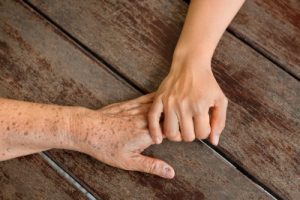
For more than 20 years, I have accompanied my daughter to her annual hepatitis B check-up with her liver specialist. She is 22 and does not need me to come, but I always go out of habit and love.
After the appointment, we sit eating lunch and I talk about how lucky she is that her liver has been healthy and her viral load undetectable for many years. Recently, she started testing negative for the hepatitis B surface antigen (HBsAg). However, she has never developed hepatitis B surface antibodies. Her immune system has cleaned house, but has lacked the power to produce enough surface antibodies to show up on lab tests and declare her free of infection.
For the second year in a row, her doctor gave her a hepatitis B vaccine shot, an experiment to see if the injection of HBsAg would spur her immune system to generate enough surface antibodies to register in a lab test.
“I don’t want to keep seeing you every year,” the doctor tells her with a smile. But it is my daughter who never wants to return to this sterile and colorless clinic. These annual visits are reminders of her mortality and the unknown period of her life when she became infected.
My daughter was born in China. At three months of age, the orphanage tested her for hepatitis B, and she tested negative. One month later, my husband and I traveled to China and we became a family. I don’t know exactly when she became infected, but I remain profoundly thankful it takes several months for a blood test to identify a hepatitis B infection. If more time had passed and her infection had been diagnosed while in China, she may have been considered “unadoptable” and our family as we know it would never have happened.
“So how do you think I got infected?” she asks me during lunch. We have discussed this before, but every year her questions and knowledge about hepatitis B become more sophisticated. But make no mistake, her question is less about infection and more about her origins, about which nothing is known.
I speculate. I tell her I doubt she was infected by her birthmother. Generally, when an infant is infected at birth, the child often experiences high viral loads or an active infection. My daughter quietly lost HBsAg with no signs of liver damage. The benign course of her infection provides no road map to her origins.
“Maybe, ironically, it was when you were vaccinated in the orphanage just before we adopted you,” I suggest. In many cases, a re-used syringe that delivers a vaccine or medicine also deliver the hepatitis B virus from the previous patient. That practice remains prevalent in many developing countries, and is a common cause of hepatitis B outbreaks in nursing homes in the United States.
We’re both quiet for a while, we know it’s all conjecture, we’re trying to build a narrative of her early life through the unreliable world of viruses and infection.
“I hope the vaccine works this time,” she says, with a weary tone. For many years, her hepatitis B infection and the annual blood draws have made her feel vulnerable and different – in addition to the visible difference of being an Asian-American child with white parents.
“I remember I had to keep quiet about my hepatitis B,” she recalls. “I was so surprised when I learned in elementary school that other kids didn’t have annual blood draws. I really want this infection to finally be over.”
Outside it’s raining and gloomy, the autumn leaves are changing color. Inside the restaurant, we are comfortable but the appointment and the reminder of the unpredictable nature of life and infections have taken their toll on both of us.
“Well, I got to get back to work,” she announces. We embrace and she leaves, and we wait to see what lab test results or cures the next year will bring.

